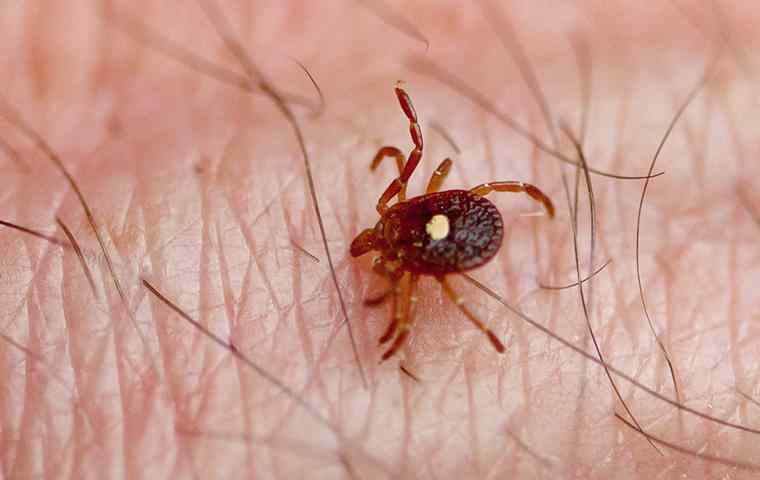

Ticks
What Are Ticks?
Ticks are eight-legged, parasitic arachnids, and are related to spiders, mites, and scorpions. Ticks are wingless and have a singular oval-shaped body region. Their heads have a pair of sensory structures (palps) to help them locate hosts and a cutting structure (chelicerae) that cuts into the skin of their host. They also anchor themselves on their host to feed using a barbed structure (hypostome).
Deer ticks are brownish-orange with distinctive darker-colored legs. Before feeding, adult ticks are about the size of a sesame seed. They are called deer ticks because their preferred host is the deer. In addition to deer, they also feed on a wide variety of other animal hosts and people.
Lone star ticks are reddish-brown and turn a slate gray color after feeding. Female lone star ticks have one white spot on their backs. Males have multiple smaller white spots. Males also have white lines around the top edge of their bodies. This species of ticks enjoy larger hosts like people, deer, and dogs, rather than smaller hosts like rodents.
Tick Frequently Asked Questions (FAQs)

Are Ticks Dangerous?
Capable of spreading many diseases to both people and animals, ticks are dangerous pests. Blacklegged ticks are responsible for transmitting Lyme disease—caused by the bacteria Borrelia burgdorferi. Lone Star ticks spread diseases like tularemia and ehrlichiosis.
Why Do I Have a Tick Problem?
Ticks are difficult to control because they are continuously introduced onto properties by wild animals. They are not capable of flying or jumping, so they move from place to place on the backs of their host. Once on your property, they hide and wait in dense, damp areas for a new host to happen by that they can attach themselves to.
Where Will I Find Ticks?
Ticks are outdoor pests, and most do not thrive inside because they can’t complete their lifecycle indoors. Most species need to lay their eggs in damp soil for them to be able to develop and hatch. Ticks rest in tall grass, wooded areas, at the edges of wooded paths, in thick vegetation, along the edges of ponds and lakes, along road ditches, and next to fence lines.
How Do I Get Rid of Ticks?
Locally owned and family-operated, All-Safe Pest & Termite is the best choice to get rid of ticks from your home or business. We offer fast response times and peace of mind knowing that your pest problems will be solved, and they won’t return. Our experienced pest control professionals provide top-quality pest control services using the latest and most effective products to eliminate ticks from Dallas properties. Discover why your neighbors choose All-Safe Pest & Termite for their pest control needs. Give us a call today!
How Can I Prevent Ticks in the Future?
Prevent problems with ticks by partnering with All-Safe Pest & Termite and by implementing the following prevention tips:
- Partner with your veterinarian and put your pets on a year-round tick control program.
- Place a stone barrier between wooded areas and your property’s lawn.
- Keep your lawn cut short and keep shrubs and bushes well-trimmed.
- Remove bird feeders from your property that attract wild animals.
- Vacuum the areas where your pets spend most of their time.
- Seal up spaces around the exterior of your home to prevent wild animals from gaining access to your home.

Get Your Free Estimate
$50 Off Your Initial Service When You Book Online!

How We Can Help You Our Services






